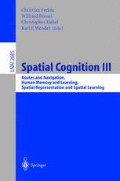Abstract
Most diagrams communicate effectively despite the fact that diagrams as a group have a minium of conventions and a high tolerance for novelty. This paper proposes that the diversity and felicity of diagrammatic representation is based on three kinds of similarity between semantic propositions and spatial representations that allow people to interpret diagrams consistently with a minimum of effort and training. Iconicity is similarity of physical appearance, polarity is similarity in the positive and negative structure of dimensions, and relational similarity aligns structures so that elements correspond to elements, relations correspond to relations, and so on. In diagrammatic reasoning detected similarities are used to create correspondences between the visual characteristics of a diagram and its semantic meaning, and those correspondences are in turn used to make inferences about unknown or underspecified meanings.
Access this chapter
Tax calculation will be finalised at checkout
Purchases are for personal use only
Preview
Unable to display preview. Download preview PDF.
References
Bauer, M. I., Johnson-Laird, P. N. How Diagrams can Improve Reasoning. Psychological Science 4 (1993) 372–378.
Bertin, J. Semiology of graphics (second edition). (W. J. Berg, Trans.). The University of Wisconsin Press, Madison, WI (1983).
Emmorey, K. The Confluence of Space and Language in Signed Languages. In P. Bloom, M. Peterson, L. Nadel, M. Garrett (eds.): Language and Space. The MIT Press, Cambridge (1996) 171–209.
Emmorey, K. Space on Hand: The Exploitation of Signing Space to Illustrate Abstract Thought. In M. Gattis (ed.): Spatial Schemas and Abstract Thought. The MIT Press, Cambridge MA (2001a) 147–174.
Fromkin, V., & Rodman, R. An Introduction to Language (sixth edition). Harcourt Brace, Fort Worth, TX (1998).
Gattis, M. Mapping Conceptual and Spatial Schemas. In M. Gattis (ed.): Spatial Schemas and Abstract Thought. The MIT Press, Cambridge MA (2001a) 223–245.
Gattis, M. Structure Mapping in Spatial Reasoning. Cognitive Development (in press, 2002).
Gattis, M. Space as a Basis for Reasoning. In J. S. Gero, B. Tversky, & T. Purcell (eds.): Visual and Spatial Reasoning in Design II. Key Centre of Design Computing and Cognition, Sydney (2001b) 15–24.
Gattis, M. Perceptual and Linguistic Polarity Constrain Reasoning with Spatial Representations. Manuscript in Preparation (2001c).
Gattis, M. Mapping Relational Structure in Spatial Reasoning. Manuscript under Review (2001d).
Gilpin, A. R., Allen, T. W. More Evidence for Psychological Correlates of Lexical Marking. Psychological Reports 34 (1974) 845–846.
Hamilton, H. W., Deese, J. Does Linguistic Marking Have a Psychological Correlate? Journal of Verbal Learning and Verbal Behavior 10 (1971) 707–714.
Huer, M. B. Examining Perceptions of Graphic Symbols Across Cultures: Preliminary Study of the Impact of Culture/Ethnicity. Augmentative and Alternative Communication 16 (2000) 180–185.
Kotovsky, L., Gentner, D. Comparison and Categorization in the Development of Relational Similarity. Child Development 67 (1996) 2797–2822.
Koul, R. K., Lloyd, L. Comparison of Graphic Symbol Learning in Individuals with Aphasia and Right Hemisphere Brain Damage. Brain and Language 62 (1998) 398–421.
Markman, A. B., Gentner, D. Structural Alignment during Similarity Comparisons. Cognitive Psychology 25 (1993) 431–467.
Marzolf, D. P., DeLoache, J. S., Kolstad, V. The Role of Relational Similarity in Young Children’s Use of a Scale Model. Developmental Science 2 (1999) 296–305.
Morford, J.P. Insights to Language from the Study of Gesture: A Review of Research on the Gestural Communication of Non-signing Deaf People. Language & Communication 16 (1996) 165–178.
Peirce, C. S. Collected Papers, Volume II: Elements of Logic (C. Hartshorne & P. Weiss, eds.). The Belknap Press of Harvard University Press, Cambridge MA (1960/Original work published 1903).
Stevens, S. S. Psychophysics: Introduction to its Perceptual, Neural, and Social Prospects. John Wiley, New York (1975).
Tversky, A. Features of Similarity. Psychological Review 84 (1977) 327–352.
Tversky, B. Cognitive Origins of Graphic Conventions. In F. T. Marchese (ed.). Understanding Images. Springer-Verlag, New York (1995) 29–53.
Tversky, B. Spatial Schemas in Depictions. In M. Gattis (ed.): Spatial Schemas and Abstract Thought. The MIT Press, Cambridge (2001) 79–112.
Vosniadou, S., Ortony, A. (eds.) Similarity and Analogical Reasoning. Cambridge University Press, New York (1989).
Wertheimer, M. Untersuchungen zur Lehre von der Gestalt, II. Psychologische Forschung 4 (1923) 301–350.
Author information
Authors and Affiliations
Editor information
Editors and Affiliations
Rights and permissions
Copyright information
© 2003 Springer-Verlag Berlin Heidelberg
About this paper
Cite this paper
Gattis, M. (2003). How Similarity Shapes Diagrams. In: Freksa, C., Brauer, W., Habel, C., Wender, K.F. (eds) Spatial Cognition III. Spatial Cognition 2002. Lecture Notes in Computer Science, vol 2685. Springer, Berlin, Heidelberg. https://doi.org/10.1007/3-540-45004-1_15
Download citation
DOI: https://doi.org/10.1007/3-540-45004-1_15
Published:
Publisher Name: Springer, Berlin, Heidelberg
Print ISBN: 978-3-540-40430-9
Online ISBN: 978-3-540-45004-7
eBook Packages: Springer Book Archive

